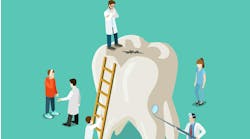Editor's note: Originally posted in 2008; reviewed for content and formatting in 2023
Frustration abounds for both patient and practitioner when an elaborate case presentation falls upon deaf ears. Face it — dentists are in competition for the discretionary consumer dollar. Patients see the pleasure of home stereos and face lifts, or maybe simply food on the table, more easily than their lasting health due to a restored dentition. And when the dentist mumbles dental terms or elaborately describes dental procedures, patients retreat … unless it is done effectively.
Take, for example, three different patients. Mr. Dunn has four kids and unsightly fluorosis that keeps him from smiling. His kids' friends ask why their dad has "dirty teeth." When he visits the dental office, he learns that he can choose from veneers, crowns, whitening ... or go out of the country where care is less expensive. Mr. Dunn is a carpenter. He leaves thinking about veneered countertops, crown moulding, and white paint because that is his frame of reference. He tells his wife that the dentist talked too fast and confused him, but he does know that he cannot get it fixed without leaving the country. Mr. Dunn further secured this outcome by telling her the cost of care. Both had sticker shock! Instead, they went out to buy a widescreen to entertain the kids for years to come.
New patient Mr. Myers has different priorities. A telephone sales manager, he arrives with asymptomatic, active periodontitis that has created several 7 to 8 mm pockets. He has excessive tissue recession, some mobility, and malocclusion because several teeth are missing. Mr. Myers has no pain and does not care about esthetics and, therefore, considers the diagnosis preposterous. He cannot believe that many of his teeth require removal. Upon departure, he agrees to call back after his heart surgery.
Finally, Ms. Takez visits a dental office after an 18-month lapse. She needs some soft-tissue management, four to five simple restorations and three full crowns, but she only wants to do a little at a time and only procedures that are completely covered by insurance. Since her annual maximum is $1,000, it will take several years to complete treatment, and she must pay a portion of each procedure. Her treatment cannot wait without risk of serious consequences. She says that she will talk to her husband, but never returns.
In these three different situations, dentists face the professional obligation to correct the problem, yet patients refuse to accept the treatment plan. Instead, they sit around with active disease and untreated problems, watching their widescreen. What is the dentist's responsibility? How can we communicate our experience with similar cases, predict the future in terms that are relevant to patients, and establish good oral health and well-being? How can we compete with a widescreen television? With a well-run team. This cannot be emphasized enough.
Dentists may pride themselves on perfectly organized protocol and fabulous marketing, yet these are worthless if the scheduler mishandles a patient on the first call. The value created in that first call actually influences case acceptance. The first visit influences it, too, before the doctor even enters the room. The team must reflect value for the procedure and level of care, rather than the medical history and insurance card. Forget them, for the time being. Who cares about an insurance card before treatment acceptance? Rather, seat the patient within five minutes and put energy into a discussion, normally initiated by questions such as, "How can we help you?"
Make eye contact with the patient and then listen, which is different from hearing. When providers listen, really listen, they understand their patients' needs and connect with them. Ask probing questions to ascertain the problem, then ask enough questions to decipher the real problem, rather than just the first one they suggest. Remember that dentists are most comfortable talking about science and techniques, but consumers do not care about these things. Patients are most interested in learning about the reason for a procedure that improves the situation, and they want a brief explanation about how the treatment will be performed. Expect patients to find dental lingo confusing; we need to have patience with them! Realize that a very detailed explanation will just cause confusion, and confused people cannot decide anything!
Once the dialogue has shown the direction of interest, ask about allergies, get a medical history, and then perform an initial screening. Copy the insurance card once patients actually accept treatment. Besides, it is often important to seek a physician's medical clearance for subsequent operative treatment. Patients historically fail to see the relevance of radiation therapy, for example, as it relates to dental treatment. Physicians' blessings ensure patient safety.
What does all this have to do with a well-run team? Team members make the first impression of professionalism, exude the quality of treatment received and solutions offered, and streamline the communication process. Dental team members have a lot of influence on patients. If done properly, the patient in their chair is willing to accept treatment before the dentist even enters the room.
It does not matter if the case is $5,000, or $45,000, the technique is the same. Case presentation and patient acceptance of treatment consist of the five T's: trust, timing, technique, tolerance, and a trained team.
Trust
Here is a bold statement: If any professional has to pronounce his honesty, it automatically forces the patient to consider that the dentist may actually not be honest.
People "sense" both honesty and integrity. Dentists have a very short time to reflect their integrity to a patient, but it will help dramatically if they promise patients only what they can reasonably deliver. A patient should never leave a consultation thinking that the dentist will grant any wish, just because the dentist listened to his or her dreams and failed to interject the realities. Dentists have a tendency to avoid disagreeing with patients. If patients receive a guarantee of specific results when there is no way the dentist can provide that, patients' intuition can "sense" this as well.
Does that make dentists liars? No. There are several reasons that case presentations fail. First, dentists do not want to lose any patients, so they try to be everything to everybody. They politely smile when a patient says that he or she wants new front teeth, which are five times whiter, for less than $1,000, in the next two weeks, for a daughter's wedding, because the patient has put it off for the last four years.
Second, dentists do not like to bear bad news. Most people would agree that it is easier to attempt to fix problems in the short run and remain the "hero," rather than face the long-term reality of any situation, especially when it pertains to body parts. Why is liposuction or a tummy tuck the cure for overweight people, rather than diet and exercise?
Third, most patients do not embrace long-term thinking when faced with short-term needs and wants. Telling patients that they "will lose their teeth someday" is akin to telling smokers that they will die of cancer. In their minds, the problem has yet to arrive, so there is no need for a solution. Finally, as professionals, enthusiasm for Implant No. 1,322 is difficult to muster.
Dentists spouting all the data and naming all the oral or physical structures involved in treatment do little to set the patient's mind at ease, particularly when spoken in a detached monotone. One must realize that No. 1,322 is routine, from a dentist's vantage point, but appears as surgery and an unbudgeted expense from the patient's perspective. The entire team must exude commitment, interest, and confidence in the patient's treatment, as the patient considers the treatment.
Timing
This is the number one deal killer. One would think that the more time that is committed to case presentation, the higher the case acceptance. I have found the opposite to be true, to a point. When I spent 90 minutes on very thorough explanations in the past, my acceptance rate was 35% to 40%. In contrast, I now spend 20 minutes really listening to my patient's needs and providing simple explanations that stress the benefits of care, and my case acceptance has risen to the 70% to 80% range. I have also found that the more I thought of myself as a dentist or dental specialist during case presentations, the worse this percentage became.
Similarly, patients should not wait long in the reception room. They just have more time to observe and look for reasons to postpone care or become more apprehensive. I have actually documented that the rate of case acceptance decreases as the length of waiting time increases.
Technique
Conventional wisdom for large case presentations has always indicated a need for diagnostic casts, radiographs, diagrams — and possibly an education-based PowerPoint. Dentists usually hit the high spots of treatment, from the vantage point of problem-solving. This causes confusion. In contrast, nonconventional wisdom includes dialogue aimed at mutual understanding of the end product, using a wax-up or photo for explanation, and includes the goal of optimal oral health and esthetics. This contributes to overall health and better quality of life. Statements about treatment always offer a solution from the vantage point of the "benefits of care," rather than solving a problem. In addition, that solution cannot be, "You'll still have your teeth in 25 years." That is too intangible! Procedures explained as analogies to real life always help patients understand the significance and urgency of treatment. For example, compare the periodontium to the foundation for a home, and then it is easy to understand that it must be sound for long-term support.
What about the nonverbal cues during case presentation? The dentist's position and posture communicate as much as the words. It is easy to lapse into a submissive, almost agonizing, frame of mind when repeatedly faced with rejected treatment plans. Face those fears! Systematically present the complete treatment needed, referencing the patient's needs and interests in life, and focusing on the benefits of treatment. It is easier said than done. It takes practice. It often requires coaching.
A different perspective of technique applies to one's level of expertise. If a patient presents with Tooth No. 8 missing, should dentists suggest a three-unit bridge just because they do not perform implants? Do they look at what is best for the patient, even if that requires a referral? It could be easily argued that one lacks integrity if they overtreat with bridgework, undertreat periodontal conditions, or perform patchwork dentistry.
Tolerance
Be prepared. Patients may have no awareness of dental diseases or modalities. Moreover, their interest level may be low. Keep descriptions simple and explain only things that are valuable to them. When patients later ask questions to clarify the procedures or financial details, do not get restless or dismiss the patient. Patients must feel genuine interest on the part of the provider.
Many consultants declare that dental professionals need scripts to communicate. However, this is robotic and emotionless. Effective dialogue revolves around the dentist's capacity to listen to patient needs and their perceived solutions. Effective decisions stem from a heartfelt interest in understanding from both patient and provider perspectives.
Handling dental treatment takes on new meaning when one discusses the benefits of care vs. the problems that require correction. Do not talk about treatment objectives; instead talk about what the specific treatment will do for the patient. Talk about the consequences involved if treatment is delayed, and discuss how this affects the patient's quality of life.
Dentists must state this clearly with confidence, and not just as "It will get worse," which is meaningless. Remember that dentists cannot control patients' financial situations, their time, or lifestyle. All they can do is emphasize the value of dental care that patients need.
Why do patients hesitate to accept a treatment plan? Their reasons fit in one of four categories:
- They do not understand the presentation, but will not admit it.
- They do not believe that the dental practice has their best interests in mind.
- They feel commanded to take action.
- They do not have a sense of urgency about the situation.
Notice that "money" is not part of the equation, though it is the excuse given. People find ways to afford something when they are legitimately convinced that they need it.
Trained team
Every team member must know which procedures are performed, why they are done, and how the patient will benefit. It is imperative that training occurs at least three times a year to explain new or changing procedures. This creates team strength, increases employee trust, and develops the synergy necessary for clear communication with patients.
Similarly, every dentist must know the power of "BUT," the first word in the sentence when attempting to justify something. All have heard "But insurance does not cover …" and "But you do not understand." "But" means an excuse is on the way! Patients are guilty, but so are dentists. Do any of the following excuses sound familiar?
- But my patients are dependent on insurance ...
- But my team is not as trained as yours ...
- But this patient never accepts any treatment, so why bother?
What about one's professional responsibility to present treatment, regardless of the outcome? No dental book states that one should only present treatment covered by insurance. Make all "buts" small or nonexistent and focus on the value — that is the best starting point for success. Using nonconventional thinking, how can the three examples presented earlier yield a favorable case acceptance? Let's reexamine the scenarios.
Mr. Dunn's children are his focus. He should recognize that sacrifices are made as a family. For example, if his son broke an arm, the family must do without something else. His self-esteem is low, he never smiles, and his children are embarrassed when friends consider their dad a "crab." Mr. Dunn must realize that he deserves physical improvement, just like his client who senses safety from newly installed doors. Perhaps a payment plan would make it easier.
Mr. Myers does not care about his smile, but he has mentioned his heart surgery in passing. This patient does not realize the ramifications of periodontal disease on the heart. Urge him to schedule a cardiology conference and determine whether a periodontal scaling and select extractions are needed well before surgery to positively affect the outcome.
Ms. Takez clearly has no sense of urgency about her care. If she had maximized her insurance benefits each year in the past, she could have reduced her overall outlay for treatment. In this situation, she must mend her ways and schedule treatment while there is viable tooth structure available and little risk of endodontic involvement, which is even more costly. The dentist must explain the way that insurance reimburses for procedures, stressing the urgency involved now that there are signs of disease.
Use these methods to take the futility out of case presentations and, in doing so, increase case acceptance. This will improve the quality of life for consumers, and they may just do without that widescreen.






